 Weather is warming here in Maine with Spring firmly in place. It was only after hearing a lot of frantic gobbling coming from under the shop’s floorboards that I realized it is turkey season… Sort of a turkey hideout in the open crawl space until things blow over. Doesn’t do much for my reputation as a hunter.
Weather is warming here in Maine with Spring firmly in place. It was only after hearing a lot of frantic gobbling coming from under the shop’s floorboards that I realized it is turkey season… Sort of a turkey hideout in the open crawl space until things blow over. Doesn’t do much for my reputation as a hunter.
Am I talkin’ to you?
Maybe not. There are lots of people out there who believe every word written was written for them and their job is to critique whatever others create. The whole notion of shared experiences, stories around the campfire, tall tales and funny stories seems to be lost on them. One group perpetually gives and they perpetually take. I’m not sure if they understand why people write.
I don’t write for…
The make believe safari taking, pinky up tea sipping, euro-tech speaking, American liberal, ten year graduate student who doesn’t own a gun, yet finds it necessary to hang around where firearms are the topic of discussion. A prayer for manhood by association I suppose or lemmings with the power of speech. Maybe even John Lemmings. Characteristic behavior – they don’t post reference links, they post “linkys”. They don’t go to a gunsmith, they go to their “smithy”… their man Jarvis, Madonna with a British accent. They Wiki know everything, they don’t actually know anything and their opinions typically spill out onto their keyboards after completely circumventing their brain. If you are one of the above, and find yourself here, quit reading. Really. No, right now! Go away. You are not in my targeted demographic and, more simply put, I don’t like you.
I do write for…
Anyone who actually owns firearms, has hunted or does hunt and, preferably, likes handloading.
Folks who wear camo when they hunt, then wear the same camo to dinner and work, and sometimes on the weekend while working on the family truck.
People who are over fifty, or have been to war at least once, or who think Ted Nugent is perhaps a little effeminate.
Crusty old pirates and curvaceous young barmaids, who lean deeply to serve tankards of ale… the barmaids, not the pirates.
People who do without and resort to daydreaming sometimes, because they always put family and friends first and never quite find time for themselves..
Why the .416 Rigby, Joe? Why?
 I don’t remember how many times I’ve tried to justify personal firearm selections to headshaking family and friends. The truth is, I just like interesting firearms and cartridges and that’s all the justification needed. As long as I didn’t under-gun a hunting piece, a practice that doesn’t fit into my idea of ethical hunting, I could over-gun as much as my wallet, shoulder and gun bearing back could take. In short, I could have fun, just for the sake of having fun and buying sporting firearms is about the smile they put on your face.
I don’t remember how many times I’ve tried to justify personal firearm selections to headshaking family and friends. The truth is, I just like interesting firearms and cartridges and that’s all the justification needed. As long as I didn’t under-gun a hunting piece, a practice that doesn’t fit into my idea of ethical hunting, I could over-gun as much as my wallet, shoulder and gun bearing back could take. In short, I could have fun, just for the sake of having fun and buying sporting firearms is about the smile they put on your face.
I like the .375 H&H and the .375 Ruger, but I wanted something larger that wasn’t followed by the notation, “Good up to cape buffalo” or “Good where legal for use on the largest game”. I wanted a cartridge proven in taking the largest game.
I miss my .416 Weatherby. It was very accurate and flat shooting with 400 grain loads, and manageable under recoil. Unfortunately, all of that fancy walnut and highly polished bright bluing made it inappropriate for brush beating in inclement weather. In short, it was a hunting cartridge, but not a hunting rifle.
A recent project, based on the .416 Ruger, concluded very favorably and suggested that cartridge could be a contender for this project. Unfortunately, at the time of this writing, it was available only in the Alaskan 20″ barrel version. An excellent hunting package, light in weight and compact in carry, but inconsistent with the full tilt .416 caliber 400 grain at 4,000 fps loads I wanted to develop. Yes, that is a joke…honest…really.
More than anything, the .416 Rigby was picked because it is a big under-loaded cartridge with lots of untapped potential. The CZ American Safari Magnum was picked because it is the right firearm to extract as much of that potential as possible while providing an extra margin of safety. It would be yet another step in the Ruger No.1 in .45-70 and .45 Colt in a Ruger Blackhawk progression.
A little more information on that .416 Rigby chambered CZ 550 Safari Magnum…
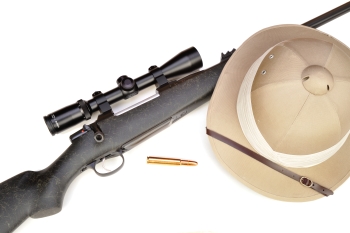 It’s a kickass gun. Sort of like a 1968 L88 Corvette is a kickass car No, it is not THE most powerful gun, but probably the most powerful gun I could say I enjoyed shooting without lying through my teeth. Certainly a gun that could kill any big and dangerous game, anywhere. CZ-USA has managed to take a combination that is typically sold as an expensive specialty item and use their extensive big gun experience to turn the premium grade American Safari Magnum into a standard production gun; an MSRP of only $1,660, or about $1,100 in real money.
It’s a kickass gun. Sort of like a 1968 L88 Corvette is a kickass car No, it is not THE most powerful gun, but probably the most powerful gun I could say I enjoyed shooting without lying through my teeth. Certainly a gun that could kill any big and dangerous game, anywhere. CZ-USA has managed to take a combination that is typically sold as an expensive specialty item and use their extensive big gun experience to turn the premium grade American Safari Magnum into a standard production gun; an MSRP of only $1,660, or about $1,100 in real money.
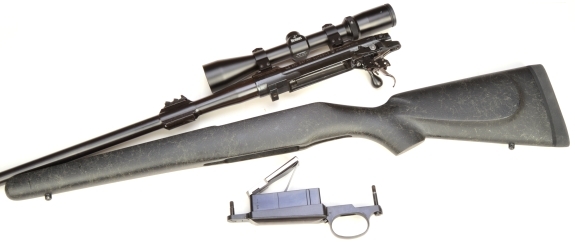
In overview, the CZ 550 Safari Magnum – Kevlar stock, blued hardware, weighs 9 lbs 12 oz, 2 lbs 10 oz of which resides with its stock. The gun is fitted with a 25″ hammer forged barrel. Twist rate is 1:16.5″. All hardware is steel, some high quality cast pieces, some forged. Overall length is 46″, pull is a longish, but comfortable 14″. Drop at the comb is approximately ¾”, drop at the heel is approximately 1 ½” from bore centerline. The recoil pad is a branded Pachmayr Decelerator, which is a very good piece for this type of rifle. The center of balance is under the front action ring.
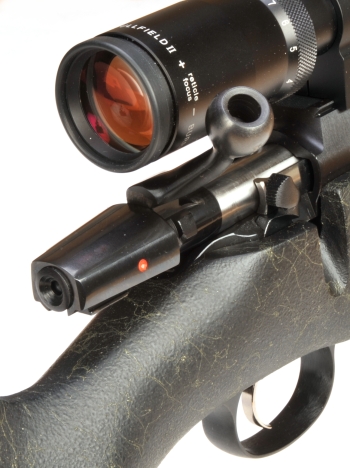
While the CZ 550 shares many common attributes with other bolt action rifles, there are also unique features that warrant mention. A scope with a standard eyepiece diameter, 1″ tube and 40mm objective requires only medium height rings for sufficient bolt handle clearance. No neck cranking or ostrich necking to look through the eyepiece, which really works for high recoil rifles.
Forward of the bolt handle is a traditional two position safety, which is positive in operation. A cocking indicator protrudes through the end of the bolt shroud when the bolt handle is rotated down to in the cocked position. A thoughtful feature.
The Safari Magnum’s stock is textured and well finished. While it is devoid of checkering, the finish provides a positive grip. I would rate the Kevlar – fiberglass stock quality as excellent. No low density surface areas, no rough recesses and mating at the barrel channel and around the upper side of the receiver is close.
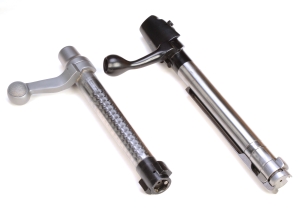 The CZ 550 Magnum is a true magnum action that can be adapted to handled cartridges all the way to the size of the giant 0.640″ case head .505 Gibbs. Right – The long CZ bolt seen next to a M700 Remington bolt.
The CZ 550 Magnum is a true magnum action that can be adapted to handled cartridges all the way to the size of the giant 0.640″ case head .505 Gibbs. Right – The long CZ bolt seen next to a M700 Remington bolt.
The CZ uses the long Mauser type extractor and is a controlled feed design. The case rim is picked up when a cartridge is stripped from the magazine and it is held in place until it is chambered. Subsequently, you can chamber a round while hanging upside down…if this is a technique you employ while hunting big game. Or a large horned animal might put you into that orientation.
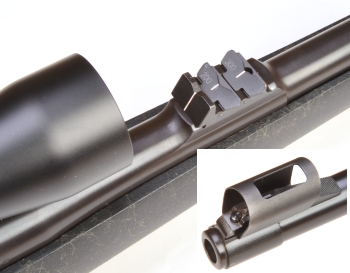
This model CZ 550 Safari Magnum includes express sights, something that doesn’t happen often with other manufacturers anymore. The forward leaf is fixed, calibrated to 100 meters, second and third leaves are set for 200 and 300 meters respectively. Why measure in meters and not yards? Cape buffalo and elephant in Africa are notorious in distancing themselves from hunters in metric increments. Rifles slated for U.S. hunters are indexed to imperial units of measurement as domestic game animals follow that standard. Rear sights may be drifted to shift horizontal point of impact.
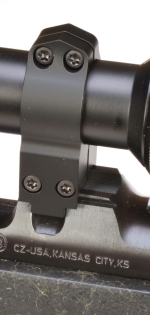 The front sight has a little light window in its brush guard to illuminate the front bead. The front sight blade is removed and reinstalled by depressing a small spring loaded button at the front of the sight. Blades are available in a variety of heights to permit vertical point of impact adjustment. The overall sight system is substantial and it makes for a big wide open visual for close in hunting of big and fast moving game. Is there a practical use for 300 meter open sights? Maybe not for me, especially with a scope in place, but they are a quality touch and much nicer than the plastic sights stuck on so many rifles these days. Scopes have become the habitual selection where open sights are probably the more correct selection.
The front sight has a little light window in its brush guard to illuminate the front bead. The front sight blade is removed and reinstalled by depressing a small spring loaded button at the front of the sight. Blades are available in a variety of heights to permit vertical point of impact adjustment. The overall sight system is substantial and it makes for a big wide open visual for close in hunting of big and fast moving game. Is there a practical use for 300 meter open sights? Maybe not for me, especially with a scope in place, but they are a quality touch and much nicer than the plastic sights stuck on so many rifles these days. Scopes have become the habitual selection where open sights are probably the more correct selection.
The CZ mount system is solid. I used 1″ Warne mounts/rings for this application. The CZ 550 Magnum is a square bridge Mauser action derivative. It has 19mm dovetail grooves cut into the receiver and a locating keyway that anchors the aft ring longitudinally. I have mounted 1″ and 30mm tube scopes on a variety of CZ rifles from a .30-06 Springfield chamber through to the .500 Jeffery. Scopes are easy to mount, they fall into place when laser bored and they do not shake loose or kill scopes as a result of poor retention. I think CZ did a good job of building an incredibly reliable sighting system for dangerous game hunting.
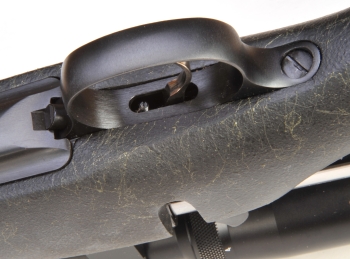
Bottom side up; All steel guard and floorplate hardware. The floorplate release is out of reach of inadvertent finger and hand contact. The magazine holds three rounds.
The single set trigger is adjustable for pull, slack and overtravel. Standard pull is adjustable from 12 – 22 Newtons. If you think of Newtons only in association with figs, that is 2.6 lbs – 4.9 lbs. This gun checked at 1 lb 2 oz set and 3 lbs 10 oz unset. With a rifle of this type, a 4 lb pull is a happy place to be, especially with a 1 lb set option for special occasions.
A Major League Stock
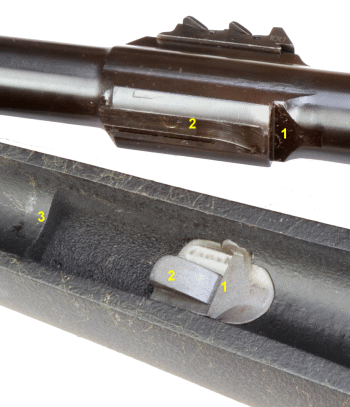 There was a time, not long ago, when the first check list item when buying a used larger caliber gun was to look for stock splits or wood divots aft of the gun’s action tang. Big CZ magnums use a variety of recoil absorption schemes to keep the stock in one piece and to eliminate those concerns.
There was a time, not long ago, when the first check list item when buying a used larger caliber gun was to look for stock splits or wood divots aft of the gun’s action tang. Big CZ magnums use a variety of recoil absorption schemes to keep the stock in one piece and to eliminate those concerns.
In the case of this Kevlar stocked model – #1 forms a meshed pair of undercut /overcut horizontal lugs. These keep the stock and action locked together vertically and moving longitudinally in unison. #2 is a longitudinal lug and keyway pairing that provides lateral stability and keep the barrel centered in the barrel channel under harsh recoil.
Minor notation – # 3 is a single pressure pad on an otherwise floating barrel arrangement. The stock includes sling swivel buttons.
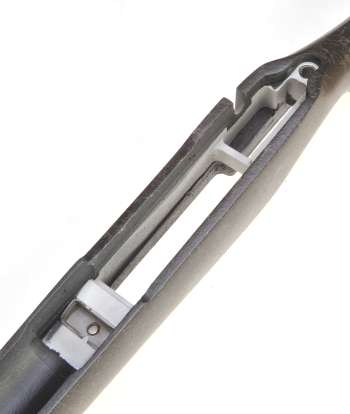
Kevlar/fiberglass stocks are not so exciting when they are two or three point mounted and do not contain an integral aluminum frame. The composite material is relatively soft, easy to compress and allows way too much walking around to ensure repeatable accuracy even with tubular inserts at the guard screws. CZ went to Bell and Carlson for a premium grade stock with a stout cast aluminum frame that securely locates the barreled action and bottom metal. In this case, another horizontal recoil lug was also added.
The frame is not minor. ¾” high at the magazine well, higher at the forward recoil lug, 1″ at the recoil lug, ¼” thick at the rails and solid filled at the fastener locations. The frame is molded right into the stock during production. The resulting assembly has a temperature operating range of -50ºF to +140ºF. Because of it’s stability the stock can come off and go on without shifting point of impact.
Does anybody really know what time it is? Sure. It’s 4:16…
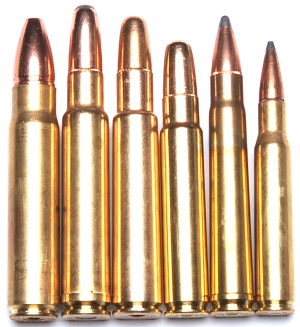
In context, the .416 Rigby is kind of a middle of the road big and dangerous cartridge. Pictured left, left to right: .500 Jeffery, .416 Weatherby Magnum, .416 Rigby, .416 Ruger Magnum, .375 H&H, .30-06 Springfield.
The Rigby was introduced in 1911, within a reasonable time frame of the H&H, Jeffery and approximately nine million other competing cartridges intended to capitalize on the then growing popularity of comparatively inexpensive bolt action rifles. The Rigby is a cruiser. With a factory loaded 410 grain bullet at 2,370 fps, its very large case capacity of 132 grains accomplishes this with only 47,000 PSI of conformal transducer measured pressure.
Much is made of the cartridge’s low chamber pressure as a safeguard against the effect of hot African climate on propellant generated pressures. Maybe, but the low pressure case may be more of a safeguard against major variations in firearm manufacturing. Unlike the H&H series that resorted to use of a case belt to headspace properly in firearms built to imprecise chamber tolerances, the Rigby employs a sharp 45° shoulder to establish headspace. At only 47,000 PSI of chamber pressure, there is a significant safety margin to prevent sticking cases and failed extraction. How much room is there to improve the Rigby’s performance in a stout rifle that has been held to precise specifications? The five grain greater capacity and belted .416 Weatherby, with a slightly shorter neck, and a little taller at the shoulder has a maximum chamber pressure of 63,800 PSI and moves a 400 grain bullet 300 – 400 fps faster than the Rigby. In the world of big boy cartridges and bullet weights, that is nearly a ton pick up in kinetic energy. Food for thought as the CZ 550 has thicker chamber walls that the Weatherby and no lesser action strength. With 5115 ft/lbs of muzzle energy and a proven killer of large and dangerous game, other than as an academic exercise, how much does the Rigby need to be pushed?
Conclusion
We have handled a good number of CZ rifles and found them to be sound firearms. I personally have several that span from standard through magnum cartridges, standard, medium and magnum version actions, all providing excellent service and interesting product design. I like the Kevlar stocked Safari Magnum because it is a particularly clean firearm and it I have no doubt it could be pressed hard and remain reliable. Part II is going to be an extensive and hopefully unique wring out of the cartridge and firearm and maybe a few new ways to look at cartridge performance.
Joe thinking out loud – feel free to skip this scratch pad for Part II
I don’t know what, exactly, makes a rifle – cartridge combination a game stopper. Kinetic energy alone doesn’t mean much. Shoot a five gallon pail full of half inch gravel with a .375 H&H Magnum and it will move a couple of inches, which isn’t much of a reaction to a direct hit on a fifty pound “animal”. I don’t think an animal of substantial size will be thumped into submission by the transfer of kinetic energy from a projectile to a target. I do believe that same caliber bullets of same design, one moving along with 10%-20% higher velocity will have a nearly linear effect on penetration, while having an exponential effect on kinetic energy.
I’d guess that deeper penetration means a longer wound channel with greater surface area, which means faster bleed out, all else being equal. The surface area of a cylinder is expressed as, although I am not sure of the pronunciation:
Surface Area of a Cylinder = 2 pi r 2 + 2 pi r h
Accordingly, a .416″ bullet that penetrates 24″ exposes roughly 32 square inches of severed blood vessels while one that penetrate 36″ exposes 47 square inches, or a 47% increase. So there’s an argument for a magnum that pushes a bullet faster than a standard cartridge of the same caliber. It is also an argument for a larger diameter bullet. As an example, a .308″ bullet driving 36″ through body mass will produce 35 square inches of wound channel surface area, or very similar to the earlier mentioned more shallow penetrating .416″ slug. Did I wear my good sweats today, or are these…?
I do believe in hydrostatic shock as causing damage to animal tissue. Not so much as a theory of shock waves, but rather one of simple rapid displacement of fluid and the destructive force distributed to tissue surrounding the would channel. 60% – 70% of a animal is water and water is not compressible. So if you can exert enough water to push it into a space, whatever is in the space will be driven outward. I’d guess the velocity of lateral displacement of fluid is proportional to the forward surface velocity of a bullet, and the amount of fluid volume displaced is equal to the bullet’s displacement when forming the wound channel. So I will change from the area of a cylinder calculation to volume of a cylinder or:
Volume of a Cylinder = b h = pi r 2 h
In the case of the .416″ bullet penetrating 36″ with an average penetrating velocity of 1,000 fps, from entry velocity to stopped, the bullet will drive approximately five cubic inches of tissue outward, where 60% – 70% of the mass will be uncompressible fluid and the fluid will be driven outward from the centerline of the bullet equal to the velocity of a bullet, beginning at, say, 2,000 fps initially slowing progressively until it comes to a stop. In my example, I used a less than scientific approach to arrive at my 1,000 fps average, but I believe this is close. Roughly 3 – 3.5 cubic inches of uncompressible fluid is going to act on 35 square inches of wound channel, the greater part of the damage done nearer to the surface and away from vital organs. Not exciting, however, it does suggest that fluid near a wound channel is moving as though it is coming from a pressure washer and, since 60%-70% of the matter displaced is uncompressible liquid, wouldn’t the serious tissue damage have to be 60% or 70% greater than the diameter of the bullet? So a .416″ bullet basically leaves a 0.665″ – 0.707″ hole where a .308″ bullet would leave a path of destruction 0.492″ to 0.523″ with an increase proportional to bullet expansion. Big bullets leave a big hole and do proportionally more hydraulic damage. I wonder what percentage of the volume of an animal’s heart would have to be rapidly displaced to cause the muscles of the heart to fail? What is the volume of an Alaskan moose’s heart?
I didn’t impress myself with myself…
Maybe none of the prior matters and I am barking up the wrong tree. That seems odd…barking up a tree’s bark. I’m hungry. I have shot deer with .243 Winchester hundred grain loads and they dropped as though they were hit with a bolt of lightning. OK, perhaps a little conjecture here as I have never actually seen a deer struck by a bolt of lightning, but let’s just go with a high impact cartoon visual of a deer first with raised eyebrows and a startled look on its face, then immediately falling to the ground, dead in its tracks. I’ve also seen deer shot with firearms approaching the power of field artillery, just trot off…not the artillery, the deer, to the point they had to be pursued to be collected. One of the reasons I am such a conservative hunter. I hate long walks through the woods in search of leaky game animals. In both cases bullet penetration was significant and more than reasonably expanded bullets were recovered from the respective cartridges. The first deer was heart shot, the second was initially lung shot with a .300 Weatherby Magnum. Process, process, process…
As a reward for a youthful interest in boxing and martial arts, I was really bad at both, I have been bopped on the nose more times than I care to remember. Unfortunately, my body never quite saw this as a rational signal for me to lay down and I became the poster boy for the ever popular statement of praise, “Boy, could that guy take a beating”. But then, one time, I sneezed when I climbed out of bed in the morning and a small spot on my lower back felt as though it had been hit with a sledge hammer, then stabbed in rapid succession with an ice pick. Yes, more conjecture, but I did instantly drop in my tracks. My conclusion was that generic impact shock had little to do with expediency of dispatching an animal, however, a bullet shock to something special in an animal’s nervous system could be good, but more so, a shot to a vital organ that causes the organ to stop playing is even better. Joe stopped thinking about all of this and went to fire up the grill
The .416 Rigby CZ 550 American Safari Magnum Part I
The .416 Rigby CZ 550 American Safari Magnum Part II

Email Notification